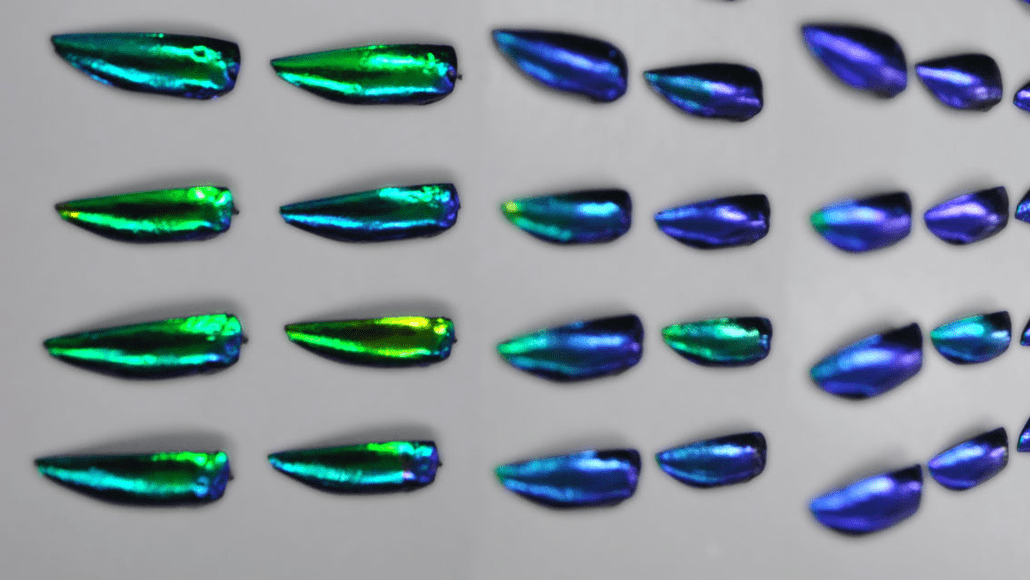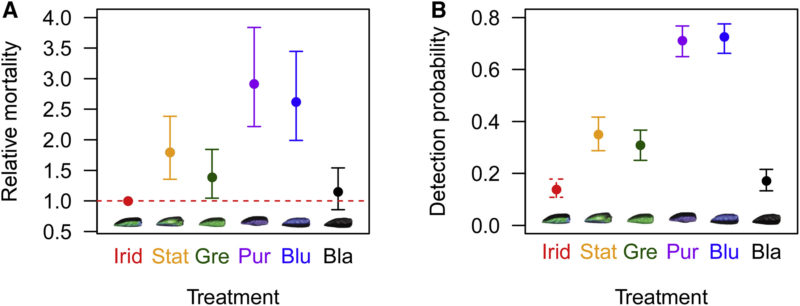Analyze This: Shimmering colors may help beetles hide
The color-changing effect of a jewel beetle’s shell seems to help it escape notice

Tilting the wing cases of jewel beetles reveals the variety of colors they take on when seen from different angles.
K. Kjernsmo
Share this:
- Share via email (Opens in new window) Email
- Click to share on Facebook (Opens in new window) Facebook
- Click to share on X (Opens in new window) X
- Click to share on Pinterest (Opens in new window) Pinterest
- Click to share on Reddit (Opens in new window) Reddit
- Share to Google Classroom (Opens in new window) Google Classroom
- Click to print (Opens in new window) Print
From peacocks to beetles, many animals are clad in colors that seem to shift as an onlooker moves. This is called iridescence (Ear-ih-DESS-ens). It’s produced when tiny structures interact with light. The structures reflect different hues when viewed from different angles. The shifting colors may help some creatures, like peacocks, attract a mate. But new research suggests there might be another purpose: camouflage.
Asian jewel beetles (Sternocera aequisignata) are sheathed in metallic-looking wing covers. This set of hard wings protects the softer wings below that are used for flying. These wing cases appear as a mix of green, blue, purple and black. What colors viewers see can change as they move, relative to the beetle. The purpose of such a changing coloration isn’t clear. Both males and females of this species sport these brilliant hues. That suggests the iridescence didn’t evolve to help a beetle impress a mate.
Scientists at the University of Bristol in England thought there may be a hidden purpose to these sparkly shells. They hypothesized that in a forest, iridescence might conceal, rather than reveal, the beetles.
To test their idea, the scientists stuffed 886 Asian jewel beetle wing cases full of mealworms. Some of the cases were iridescent. The researchers colored others with nail polish. They painted them green, blue, purple or black. These hues closely matched colors on the iridescent wing covers. The scientists painted another set of wing cases using a combo of the colors. But unlike the iridescent wing cases, these colors would not change as a viewer moved.
The scientists pinned the wing cases to leaves in a forest and left them there to see whether birds would “prey” upon them. After two days, the researchers tallied how many were left. They also tested how well people spotted the cases on leaves.
Iridescent and shiny colors may help beetles hide best compared with other colors or color combos, they found. The team shared its findings February 3 in Current Biology.

Data Dive:
- Why do you think the researchers plotted the data in figure A the way that they did? How else could you show the same results?
- What is the best color or combo of colors for a beetle to avoid becoming a bird’s dinner? Which is worst?
- What color is the best to avoid detection by humans? Which is the one most likely to be detected?
- Why do you think the scientists used a rainbow color wing case for comparison with iridescent ones?
- How might the data in these figures help explain why so many insects are black?







